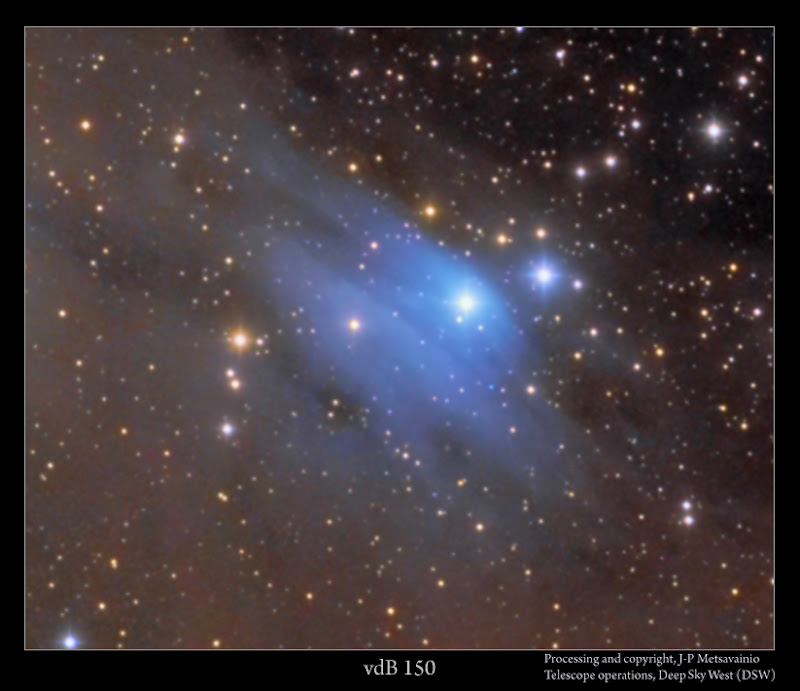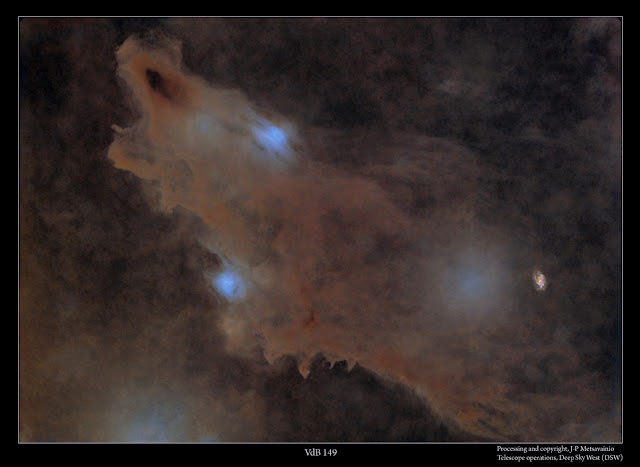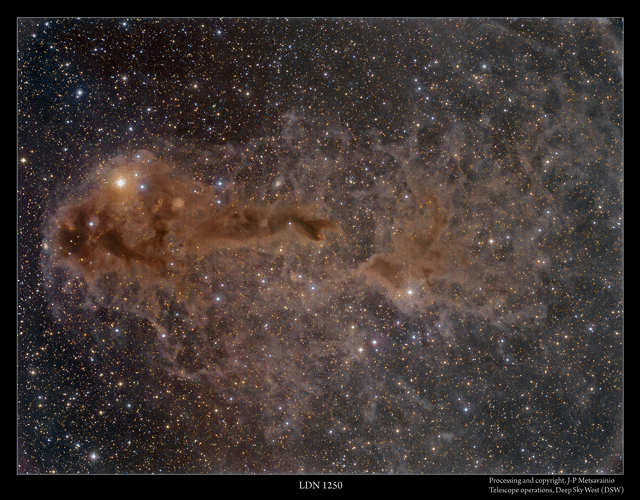COPYRIGHT, PLEASE NOTE
All the material on this website is copyrighted to J-P Metsavainio, if not otherwise stated. Any content on this website may not be reproduced without the author’s permission.
BUY A MUSEUM QUALITY POSTER
BUY A POSTER:https://astroanarchy.zenfolio.com/
Sunday, September 6, 2015
"Howling Wolf" Nebula, vdB 149, vdB 150, LDN 1235 and PGG 67671
The second photo published from the Deep Sky West observatory. Lights are taken under a very dark skie. Unlike in my current light polluted location, it's now possible to image broadband targets, galaxies, reflection nebulae and dark nebulae! HERE is some more info about the Deep sky West Observatory.
I gave the nickname "Howling Wolf" after I saw the photo first time in my monitor. At the end of this blog post, there is an explanation for the nickname.
VdB 149 and companions in the constellation Cepheus
Click for a large image
Beautiful collection of dark and reflection nebulae in Cepheus including a galaxy. This is a broadband LRGB image in natural colors.
Full resolution details from the image above
LDN 1235
vdB 150
vdB 149
vdB 149 and some interesting shapes in the dust cloud
Click for a large photo
PGG 67671
An experimental starless version
Click for a large photo
A starless version to show better the actual dust cloud
Howling Wolf
This is how I see the photo in my head.
An animated GIF, stars vs starless
Click for a large image
Technical details
Processing workflow
Stacked and calibrated in CCDStack2.
Deconvolution with a CCDStack2 Positive Constraint, 27 iterations, added at 33% weight
Color combine in PS CS3
Levels and curves in PS CS3.
Imaging optics
Takahashi FSQ-106EDXIII
Mount
Astro-Physics Mach1AP GTO with GTOCP3
Cameras and filters
QSI683WSG
Astrodon Luminance Tru-Balance E-Series Gen
Astrodon Red Tru-Balance E-Series Gen 2
Astrodon Green Tru-Balance E-Series Gen 2
Astrodon Blue Tru-Balance E-Series Gen 2
Exposure times
Luminance, 32 x 900s = 8h
Red = 13 x 900s = 3.25h
Green = 12 x 900s = 3h
Blue = 5 x 900s = 1.25h
Total 15.5h
Labels:
nebula
Friday, September 4, 2015
Half a million stars and Messier 7
This is a second image produced as a collaboration with me and Eric Recurt. The data is shot from his observatory at Tenerife. The Observatory locates at 2400 m altitude and at 28 degrees North. The site has excellent seeing conditions, 0.8 " on average and can be below 0.3 "
Messier 7, "My God, it's full of stars!"
Be sure to click for a full size image! (Quote, 2001: A Space Odyssey)
Just right from the Messier 7 locates a dark nebula B 287. In this image is visible about 500.000 stars of our Milky Way. Click the photo to see all of them! (2100x2100 pixels)
A closeup of Messier 7
Click for a large image
Planetary nebula PN Hf2-1
Click for a large image
Planetary Nebula PN Hf2-1 is a blue dot at middle of the image area.
INFO
Technical details
Processing workflow
Deconvolution with a CCDStack2 Positive Constraint, 27 iterations, added at 33% weight
Color combine in PS CS3
Levels and curves in PS CS3.
Imaging optics
340mm F3.3 astrograph
Mount
ASA DDM 85
Cameras and filters
FLI PL 16803
Exposure times
Luminance, 11 x 300s = 55min
Red = 6 x 180s = 18min
Green = 6 x 180s = 18min
Blue = 6 x 180s = 18min
Total 1h 49min
Labels:
star clusters
Rosette Nebula from a professional observatory in Tenerife
This is my second remote image this year but with different partner. I get contacted by Eric Recurt and we started a cooperation between us. The imaging season, up here 65N, hasn't started yet. This is a great way to produce high quality photos during my mandatory summer pause.
Observatory
The Observatory locates at 2400 m altitude and at 28 degrees North. The site has excellent seeing condition usually below 1" year , 0.8 " on average to be exact and can be below 0.3 "
Instruments
The instrument is a 340mm F3.3 astrograph with FLi Pro 16803 + Centerline 10 position filter wheel on a DDM 85 mount .
The first published photo from Teneriffe,
NGC 2244, the Rosette Nebula
Click for a large image
This is a broadband LRGB image of the Rosette Nebula from a remote observatory in Tenerife.
A closeup
Click for a large image
Technical details
Processing workflow
Deconvolution with a CCDStack2 Positive Constraint, 27 iterations, added at 33% weight
Color combine in PS CS3
Levels and curves in PS CS3.
Imaging optics
340mm F3.3 astrograph
Mount
ASA DDM 85
Cameras and filters
FLI PL 16803
Exposure times
Luminance, 10 x 600s = 1h 40min
Red = 5 x 300s = 25min
Green = 5 x 300s = 25min
Blue = 5 x 300s = 25min
Total 2h 55min
An experimental starless version as an animation
Labels:
nebula
Thursday, September 3, 2015
Something new! My first light from The Deep Sky West (DSW) remote observatory
The imaging season, up here 65N, hasn't start yet. I have had a wonderful opportunity to use couple of remote telescopes. One in Canary islands and the other in New Mexico. I'll publish more images from both telescopes soon.
The first photo published is from Deep Sky West observatory. It's taken under a very dark sky. Unlike in my current light polluted location, it's now possible to image broadband targets, like galaxies, reflection nebulae and dark nebulae! HERE is some more info about the Deep sky West Observatory
LDN 1250 & 1251
A natural color LRGB photo of the dark nebula LDN 1250 in Cepheus
Closeups
Click for a large image
Galaxy behind the dust
Magnitude 16 galaxy at middle of the image is PGC 166755, size 1.3 x 0.6 arcmin.
An experimental starless photo of LDN 1250 & 1251 as an animation
The nebula stands out nicely without stars. There are couple of much more distant galaxies at the image. One at right most left and the other at upper left from middle.
INFO
Image contains objects LDN 1251, LBN 558, PGC 69472, PGC 166755
This low mass star forming region in Cepheus is an extended cloud of gas and dust. There are two galaxies visible in the image. At most left middle lays magnitude 15.5 galaxy PGC 69472, angular dimensions are
2.1 x 1.6 arcminutes. Galaxy PGC 166755 At middle left shines at magnitude 16 and has size of 1.3 x 0.6 arcminutes.
Technical details
Processing workflow
Stacked and calibrated in CCDStack2.
Deconvolution with a CCDStack2 Positive Constraint, 27 iterations, added at 33% weight
Color combine in PS CS3
Levels and curves in PS CS3.
Imaging optics
Takahashi FSQ-106EDXIII
Mount
Astro-Physics Mach1AP GTO with GTOCP3
Cameras and filters
QSI683WSG
Astrodon Luminance Tru-Balance E-Series Gen
Astrodon Red Tru-Balance E-Series Gen 2
Astrodon Green Tru-Balance E-Series Gen 2
Astrodon Blue Tru-Balance E-Series Gen 2
Exposure times
Luminance, 26 x 900s = 6.5h
Red = 14 x 900s = 3.5h
Green = 14 x 900s = 3.5h
Blue = 14 x 900s = 3.5h
Total 17h
A single calibrated and stretched 15 min. Luminance frame as it comes from the camera
Click for a large image
Labels:
nebula
Subscribe to:
Comments (Atom)






























